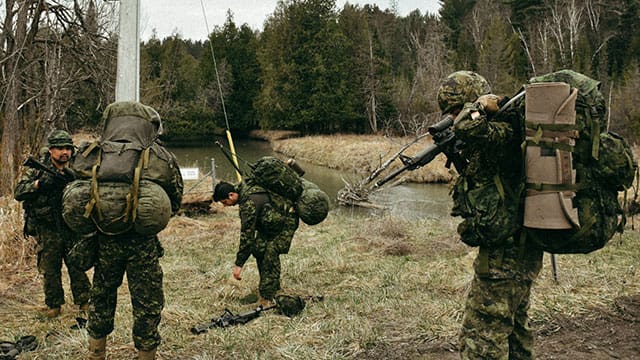Our ability to defend our freedoms and security undermined by the Trudeau government’s reckless overspending
 Good money managers always keep a little cash on hand for expenses they cannot foresee. If only the short-term thinkers in our federal government could figure that out.
Good money managers always keep a little cash on hand for expenses they cannot foresee. If only the short-term thinkers in our federal government could figure that out.
Two years ago, the Trudeau government committed to conducting a defence policy review in response to a series of international crises that – in the government’s own words – have created a world that is “less secure and less predictable.”
From Russia’s invasion of Ukraine to North Korean leader Kim Jong Un’s belligerence to China’s and Russia’s encroachment into portions of the Arctic that Canadians claim as theirs, there are glaring warning signs that it’s time to circle the wagons. It once again feels as though dark forces are pushing the world into a perilous state.
Those of us who believe our freedoms are only as secure as our ability to defend them are feeling heightened alarm. And yet, the federal government appears unable to rise to the challenge.
The defence policy review remains stalled behind closed doors. A report by Robert Fife and Steven Chase of the Globe and Mail quotes an unnamed source who says the Liberal caucus is choking on the cost of rebuilding our sadly depleted military equipment, such as submarines, tanks and drones.
The source told the Globe reporters the government keeps delaying publication because of the “sticker shock” for new equipment. According to the Canadian Global Affairs Institute think tank, there are about $100 billion of unfunded capital asset replacement projects.
And then there’s the personnel. It is believed the military is about 16,000 members below full strength and its branches are operating below readiness thresholds half the time.
All of this flies in the face of the good intentions expressed by the Trudeau government. Two years ago, the government promised to boost the defence budget by $553 billion over the next 20 years. In July 2023, the government signed on to a NATO communiqué that stated parties to the military alliance would “make an enduring commitment to invest at least two percent of our Gross Domestic Product (GDP) annually on defence.” One-fifth of that was to go toward major equipment and research and development.
The reality falls far short of the aspirations. NATO released estimates in March saying Canada is only spending 1.33 percent of GDP on defence, and there is no clear timeline for our country to meet its commitments.
Reasonable people might ask, what is the problem? The answer is infuriatingly simple.
The government has run up the federal debt, spending well beyond the revenue it takes in. Finance Minister Chrystia Freeland’s budget projects total expenditures will be $496.9 billion in 2023-24. When the Trudeau government assumed power in 2014-15, total expenditures were $289.4 billion. The federal government’s current debt is more than $1.2 trillion, or nearly $31,000 for every person in the country, according to debt.ca.
Where is all the money going? A lot of it is program spending – i.e., various programs the federal government has gotten involved in. In 2014-15, program spending was 12.8 percent of gross domestic product (GDP). Today, program spending is more than 16 percent of GDP.
Part of the increased spending is driven by commitments the Trudeau government made to the federal NDP in a deal that would ensure the minority government would not be forced into an election before 2025. Chief among those are laudable but hugely expensive programs: a national pharmacare program would cost $32 billion over four years, according to an estimate from the federal budgetary office, and a dental care program for Canadians without coverage would be $4 billion in the first year alone.
And then there was the (supposedly) once-in-a-lifetime spending during the COVID-19 pandemic on the Canada Emergency Wage Subsidy (CEWS) and Canada Emergency Response Benefit (CERB) – programs that were hastily rolled out without a vetting mechanism in place. The Fraser Institute puts the amount of money wasted at $89.9 billion, adding $8.3 billion to present-day interest costs.
Finally, there is a federal public service. In the first seven years of the Trudeau government, the number of federal employees increased by 31 percent, or nearly 80,000 new employees. (Compare that to the 16,000 personnel the military needs right now – one-fifth the number of bureaucrats the feds have added.)
It’s clear the rainy day fund has been drained. The federal government has committed to spending so much money, in part just to cling to power, that there is little left to bolster our military at a time when we need it to be in fighting form.
This is troubling. Canada has had a proud military history, punching above its weight in both world wars, in Korea, in Afghanistan, and in multiple peacekeeping roles. But since the 1960s, successive federal governments have been relying on the “peace dividend” – spending as little as possible on the military because we felt we didn’t need to at a time when global threats appeared to be easing.
And, of course, we had our big brother, the United States, right next door to help keep us safe.
That era, if it ever truly existed, is over. The hounds of war are at the door, and even our once-reliable neighbour to the south is seriously toying with re-electing an erratic totalitarian despot whose understanding of international trade relations wouldn’t get him out of elementary school.
We must, once again, take destiny into our own hands.
I’ve had debates with my peacenik friends. I agree; it’s a shame we have to spend money on war machines when we could put those resources to better use. If only Putin, Kim, Xi, ISIS, and a thousand other people and radical groups didn’t hold vastly different views of the world order.
Getting our military back to where it needs to be will not only take an enormous injection of cash and long-term commitment from the Department of Defence. It will also take a government that can reorder our spending priorities so we have the fiscal capacity to live up to the promises we have made to ourselves and our allies.
If you are wondering how much is at stake, just look to Ukraine.
Alas, this government has neither the resolve nor the capacity to rebuild our military. Surprisingly, Conservative leader Pierre Poilievre has not shown the level of outrage over the shortfall in defence spending one would expect. Given that, as prime minister, Trudeau is a dead man walking, and the Conservative leader is his likely successor, Poilievre would do well to make an unbreakable commitment to breathe new life into our military.
Doug Firby is an award-winning editorial writer with over four decades of experience working for newspapers, magazines and online publications in Ontario and western Canada. Previously, he served as Editorial Page Editor at the Calgary Herald.
For interview requests, click here.
The opinions expressed by our columnists and contributors are theirs alone and do not inherently or expressly reflect the views of our publication.
© Troy Media
Troy Media is an editorial content provider to media outlets and its own hosted community news outlets across Canada.



